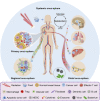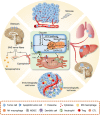The theory of tumor ecosystem
- PMID: 35642770
- PMCID: PMC9257988
- DOI: 10.1002/cac2.12316
The theory of tumor ecosystem
Abstract
Cancer cells can be conceived as "living organisms" interacting with cellular or non-cellular components in the host internal environment, not only the local tumor microenvironment but also the distant organ niches, as well as the immune, nervous and endocrine systems, to construct a self-sustainable tumor ecosystem. With increasing evidence for the systemic tumor-host interplay, we predict that a new era of cancer therapy targeting the ecosystemic vulnerability of human malignancies has come. Revolving around the tumor ecosystem scoped as different hierarchies of primary, regional, distal and systemic onco-spheres, we comprehensively review the tumor-host interaction among cancer cells and their local microenvironment, distant organ niches, immune, nervous and endocrine systems, highlighting material and energy flow with tumor ecological homeostasis as an internal driving force. We also substantiate the knowledge of visualizing, modelling and subtyping this dynamically intertwined network with recent technological advances, and discuss ecologically rational strategies for more effective cancer therapies.
Keywords: ecological therapy; neuroendocrine system; onco-sphere; pre-metastatic niche; tumor ecosystem; tumor immunity; tumor microenvironment; tumor-host interplay.
© 2022 The Authors. Cancer Communications published by John Wiley & Sons Australia, Ltd. on behalf of Sun Yat-sen University Cancer Center.
Conflict of interest statement
The authors declare no competing interests.
Figures


References
-
- Horning SJ. A new cancer ecosystem. Science. 2017;355(6330):1103. - PubMed
Publication types
MeSH terms
LinkOut - more resources
Full Text Sources
Medical

